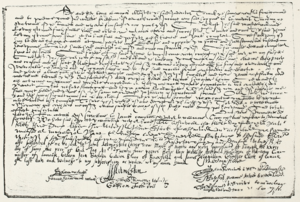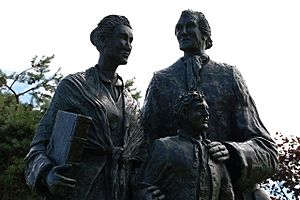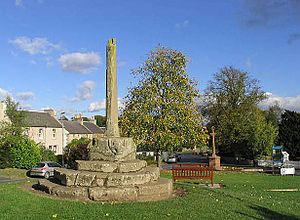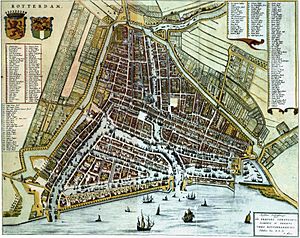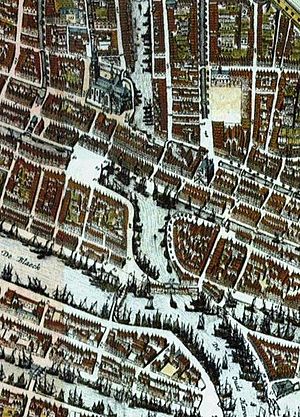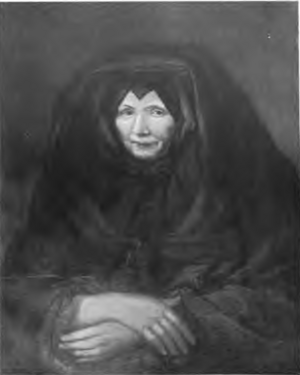John Livingstone (minister) facts for kids
Quick facts for kids John Livingstone |
|
|---|---|
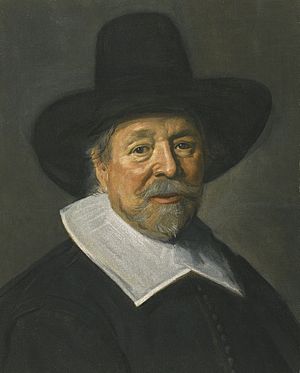
Portrait by Frans Hals
|
|
| Church | Church of Scotland Church of Ireland |
| Personal details | |
| Born | 1603 Kilsyth |
| Died | 1672 Rotterdam |
| Nationality | Scottish |
| Denomination | Presbyterian |
| Occupation | Minister |
| Alma mater | University of Glasgow, University of St. Andrews |
| Signature |  |
John Livingstone (born 1603, died 1672) was an important Scottish minister. He was known for his strong beliefs and powerful sermons. He lived during a time of big changes in the church and in Scotland.
Livingstone was the son of William Livingstone, who was also a minister. John studied at the University of Glasgow and University of St. Andrews. He became a minister in 1625. He faced many challenges because he refused to follow certain church rules. This led to him being suspended and even banished from Scotland.
He spent his later years in Rotterdam, studying and writing. John Livingstone is remembered as a dedicated and influential figure in Scottish church history.
Contents
Early Life and Education
John Livingstone was born on January 21, 1603, in Kilsyth, Scotland. His father, William Livingstone, was a minister. His mother was Agnes Livingstone.
John went to Stirling High School from 1613 to 1617. He studied Latin and Greek there. He then attended the University of Glasgow, graduating in 1621. His father wanted him to become a country gentleman. However, John felt called to become a minister.
He studied theology at St Andrews. He received his license to preach in 1625. John was a very religious person from a young age. He said he didn't remember a specific moment of conversion.
Starting His Ministry
After becoming licensed, John Livingstone worked as an assistant minister. He helped in the parish of Torphichen. Later, he became a chaplain to the Countess of Wigton. He was a very popular preacher.
In June 1630, he gave a famous sermon at the Kirk of Shotts. This sermon was said to have deeply affected about 500 people. Many churches wanted him to be their minister. But John refused to agree to certain church rules of the time. These rules were called the Five Articles of Perth.
Because of this, he couldn't get a permanent position in Scotland. He often preached for less than half an hour. This was considered quite short back then.
Ministry in Ireland
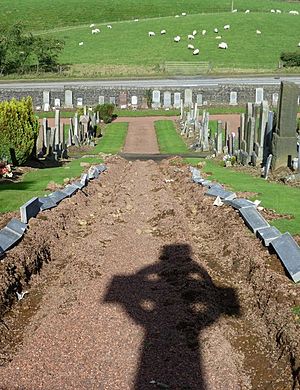
In 1630, John Livingstone moved to Ireland. He was invited by Lord Clandeboye. Soon after, he became the minister of Killinchy in County Down. He was ordained by Scottish ministers. They worked with Bishop Knox to make the ordination ceremony acceptable to Scots.
In 1631, Livingstone was suspended from his duties. This was because he did not conform to certain church practices. But he was soon allowed to return thanks to Archbishop Ussher. However, Bishop Echlin was not happy with him. In 1632, Bishop Echlin removed him from his position and excommunicated him.
Livingstone decided to move to America. In September 1636, he sailed with 140 other Puritans. They were on a ship called the Eagle Wing. But a big storm forced them to turn back. They returned to Scotland after almost two months at sea.
Returning to Scotland
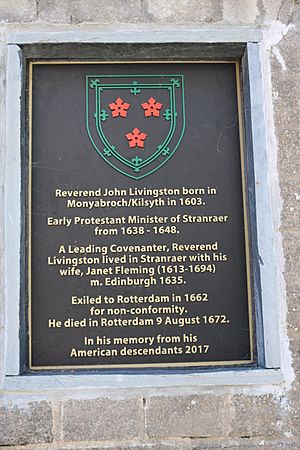
In 1638, John Livingstone signed the National Covenant. This was an important document for Scottish Presbyterians. He was then sent to London. His job was to share copies of the Covenant with supporters.
In July 1638, he became the minister of Stranraer. His sermons there were very popular. Many people, including those from his old parish in Ireland, came to his communion services. In 1640, he served as a chaplain for the Earl of Cassillis's army. He even wrote about a battle he witnessed.
During his time in Stranraer, he often visited Ulster in Ireland. He preached to Scottish soldiers stationed there.
Later Ministry and Challenges
In 1648, Livingstone moved to the parish of Ancrum in Roxburghshire. He was chosen to negotiate with King Charles II in 1650. This was about the terms for Charles to become king. Livingstone made the king promise to uphold the Covenants. However, Livingstone did not fully trust the king.
He later joined a group that opposed the king's coronation. He was asked to write a history of the Church of Scotland. But he never finished it. In 1651, he became the leader of a group called the Protesters. He even preached before Cromwell in London in 1654.
After the king returned to power, Livingstone faced more trouble. In 1662, he refused to take the Oath of Allegiance. This oath had parts he disagreed with. Because of his refusal, he was banished from Scotland.
There was an incident in his Ancrum parish after his banishment. A new minister was appointed, but some people opposed him. During a dispute, a woman tried to speak with the new minister. This led to a confrontation. Some boys then threw stones. As a result, some people were punished severely.
Life in Rotterdam
John Livingstone chose to live in Rotterdam, Netherlands, after his banishment. He spent the rest of his life there. He often preached in the Scottish church in Rotterdam. He also spent a lot of time studying. He worked on a Latin translation of the Old Testament. However, this work was never published.
He passed away on August 9, 1672, at the age of 70. John Livingstone was known as a very gifted preacher. He was described as modest and calm. He knew many languages, including Latin, Hebrew, and French. In his later years, he disliked divisions within the church.
Family Life
John Livingstone married Janet Fleming in 1635. She was the daughter of an Edinburgh merchant. They had a large family together. One of their sons moved to America. His descendants became well-known there.
Original portraits of John Livingstone and his wife can be seen at Gosford House in East Lothian.
His Writings
John Livingstone wrote several important works. These include:
- A Letter to his Paroch (1663)
- A Brief Historical Relation of the Life of Mr John Livingston (published in 1754)
- Memorable Characteristics and Remarkable Passages of Divine Providence (published in 1754)
He also wrote other letters and papers. These writings give us a good look into his life and beliefs.
Images for kids


